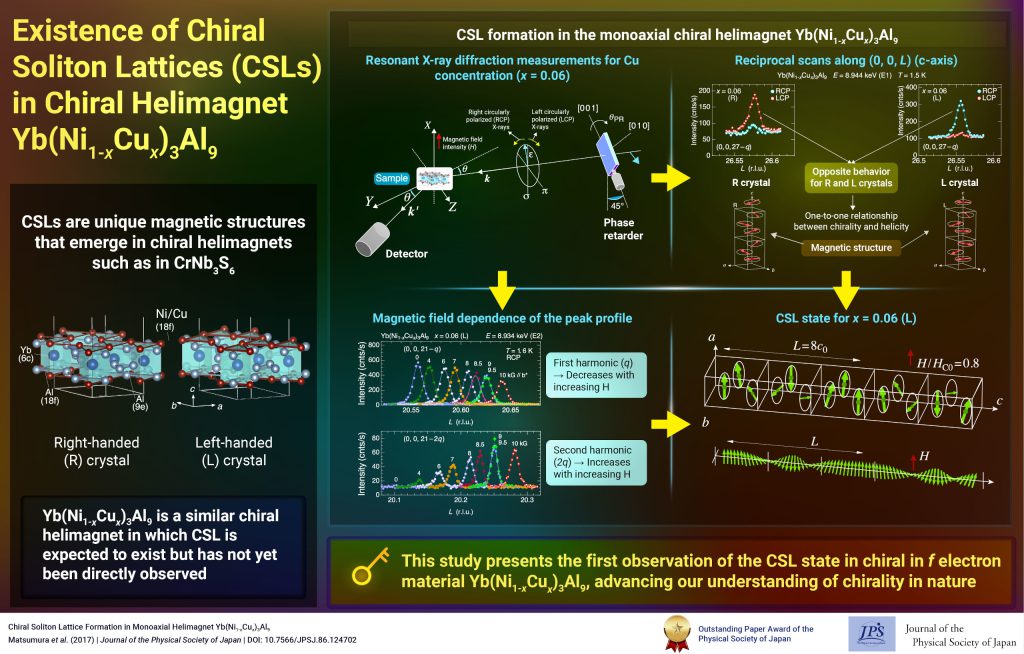Existence of Chiral Soliton Lattices (CSLs) in Chiral Helimagnet Yb(Ni1-xCux)3Al9
© The Physical Society of Japan
This article is on
Chiral Soliton Lattice Formation in Monoaxial Helimagnet Yb(Ni1−xCux)3Al9
(The 30th Outstanding Paper Award of the Physical Society of Japan)
J. Phys. Soc. Jpn.
86,
124702
(2017)
.
Our study examines the magnetic structure of the monoaxial chiral helimagnet Yb(Ni1-xCux)3Al9, providing first direct evidence of the formation of chiral soliton lattice state.

Chirality is the fundamental property of symmetry in nature that influences the physical properties of both inorganic and organic substances. Consequently, it has gained significant attention in materials science in the last decade.
In magnetic chiral crystals, which lack both inversion and mirror symmetries, the effect of the antisymmetric Dzyaloshinskii–Moriya (DM) interaction leads to a helimagnetic ground state. Applying a magnetic field along the helical axis in such a system transforms this helimagnetic ground state into a topological spin structure, such as magnetic skyrmions and chiral solitons.
The existence of a chiral soliton lattice (CSL) state was first predicted theoretically and later confirmed in the monoaxial chiral helimagnet CrNb3S6, a transition metal compound. Such materials can offer new functionalities by tuning the CSL state, with potential applications in spintronics.
Recently, magnetization measurements of Yb(Ni1-xCux)3Al9—a new monoaxial chiral helical magnet, have indicated the presence of a CSL state. Previous studies have shown that substituting nickel (Ni) with copper (Cu) results in an anomalous magnetization curve. Specifically, at 6% Cu doping, the magnetization resembles a CSL state, though it has not been directly observed.
In this study, we investigated the magnetic structure of Yb(Ni1-xCux)3Al9 through resonant X-ray diffraction (RXD). We performed RXD measurements using both right-circularly polarized (RCP) and left-circularly polarized (LCP) X-rays on the right-handed (R) and left-handed (L) crystal specimens of Yb(Ni1-xCux)3Al9 at different Cu concentrations.
Notably, the helicity of the magnetic structure depended on chirality of the crystal, as evident from the opposite behaviour of RCP and LCP X-rays for the R and L crystals in reciprocal space scans. This confirms the presence of an antisymmetric exchange interaction, i.e. the DM interaction.
Furthermore, when a magnetic field was applied perpendicular to the helical axis, second and third harmonic peaks were detected in the RXD pattern for crystals with 6% Cu doping. On increasing the magnetic field, the intensity of the first harmonic decreased while those of higher harmonic peaks increased. This behaviour, consistent with chiral Sine-Gorden model, provides compelling evidence for CSL state formation.
Remarkably, the period of the CSL is locked to the lattice when it is exactly three turns over eight unit-cells. These insights deepen our understanding of chirality-induced magnetic structures and their potential applications.
Our study is the first to demonstrate the presence of CSL state in Yb(Ni1-xCux)3Al9 and was honoured with the Outstanding Paper Award of the Physical Society of Japan.
Chiral Soliton Lattice Formation in Monoaxial Helimagnet Yb(Ni1−xCux)3Al9
(The 30th Outstanding Paper Award of the Physical Society of Japan)
J. Phys. Soc. Jpn.
86,
124702
(2017)
.
Share this topic
Fields
Related Articles
-
Higher-Order Topological Phases in Magnetic Materials with Breathing Pyrochlore Structures
Electronic structure and electrical properties of surfaces and nanostructures
Magnetic properties in condensed matter
Mathematical methods, classical and quantum physics, relativity, gravitation, numerical simulation, computational modeling
2025-4-7
A simple example of a higher-order topological phase, in which the symmetry decreases step-by-step from the bulk to the corner, is realized in a magnetic system with a pyrochlore structure and is characterized by a series of quantized Berry phases defined for the bulk, surface, and edge.
-
Understanding Pressure-Induced Superconductivity in CrAs and MnP
Magnetic properties in condensed matter
2025-3-10
This study reviews existing research on the pressure-induced variation of magnetic properties of transition metal mono-pnictides like CrAS, MnP, and others, aiming to understand the unconventional superconductivity observed in CrAs and MnP.
-
Symmetry and AI: Building the Future of Physics Simulations
Magnetic properties in condensed matter
Measurement, instrumentation, and techniques
2025-2-18
Generative artificial intelligence (AI) has gained considerable attention in scientific fields. By embedding physical symmetry into AI before training, we created a faster and lighter model. Scaling improves the accuracy and unlocks the potential of physics research and applications.
-
Triangular Lattice Magnet GdGa2: Spin Cycloids and Skyrmions
Cross-disciplinary physics and related areas of science and technology
Electronic transport in condensed matter
Magnetic properties in condensed matter
2025-2-3
Careful measurements were conducted on the hexagonal magnet GdGa2 to reveal the experimental signatures of ultrasmall spin cycloids and of a potential Néel-type skyrmion lattice phase induced by a magnetic field.
-
Spin-Spin Interaction Mediated by Rotational Lattice Vibrations
Magnetic properties in condensed matter
Structure and mechanical and thermal properties in condensed matter
2025-1-24
This study predicts the presence of spin-spin interactions mediated by the angular momentum of lattice vibrations, which can be long-range.




